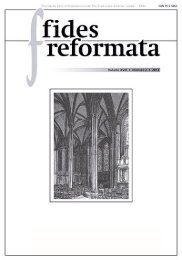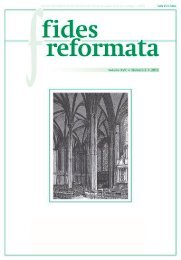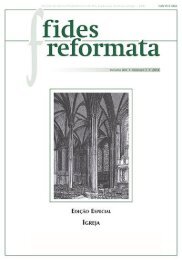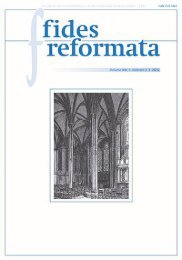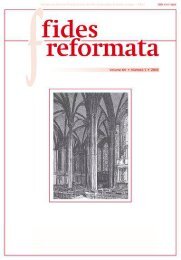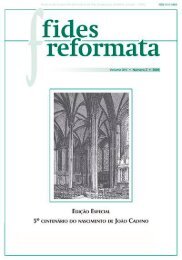Create successful ePaper yourself
Turn your PDF publications into a flip-book with our unique Google optimized e-Paper software.
P.H.R. (Rob) van Houwelingen, John and the Others<br />
More specifically, the results of this essay may be summarised in five<br />
points:<br />
1. In the prologue (1:1-18) and the epilogue (that formally starts in 21:23)<br />
“we” should be understood as including the author as an eyewitness.<br />
He acts as the spokesman of a circle of observers who are in a position<br />
to confirm and support his testimony.<br />
2. Through the “we-form” the author <strong>do</strong>es not wish to identify himself<br />
with his readers or to dignify his style of writing. Rather, he desires<br />
to emphasize the unique reality of being witness. The Fourth Gospel<br />
is framed by John’s testimony together with that of his fellow eyewitnesses.<br />
3. In the prologue, “seeing God’s glory” could include a reference to<br />
the transfiguration. In that case “we” would point to John, James,<br />
and Peter in particular. The “we”, however, should not be restricted<br />
to those three eyewitnesses. John 12 records a public occasion of<br />
glorification, while the transfiguration was a private event.<br />
4. In chapter 20:30-31 the Fourth Gospel gives the statement of purpose<br />
in the passive form (it is linked to the confession of Thomas), while<br />
chapter 21:24-25 differs with that because it has a more personal<br />
ending (linked with the last statement on the beloved disciple).<br />
5. Through the eyes of John as the longest living apostle who was also<br />
the chief witness, the end of the Fourth Gospel looks forward to the<br />
apostolic period that had already started at the time of the publication<br />
of his book.<br />
resumo<br />
Tanto em seu prólogo quanto no seu epílogo, o Quarto Evangelho usa um<br />
pronome correspondente da primeira pessoa na forma plural: nós. Isso levanta<br />
uma questão para o leitor: qual é a identidade daqueles que dizem “vimos a sua<br />
glória” (1.14) e “sabemos que o seu testemunho é verdadeiro” (21.24)? Para<br />
responder essa pergunta, outros indícios textuais <strong>do</strong> Quarto Evangelho precisam<br />
ser leva<strong>do</strong>s em consideração, em particular aqueles nos quais o autor se<br />
dirige diretamente ao leitor (<strong>19</strong>.35: o testemunho singular da morte de Jesus na<br />
cruz; 20.30-31: não somente o final <strong>do</strong> livro, mas sua declaração de propósito,<br />
ligada à confissão de Tomé). Além disso, existe a evidência <strong>do</strong> chama<strong>do</strong> Cânon<br />
Muratoriano, segun<strong>do</strong> o qual os outros discípulos incentivaram João a escrever<br />
o seu evangelho e leram junto com ele o que ele escrevia. Este artigo propõe o<br />
seguinte argumento: o “nós” em questão deve ser interpreta<strong>do</strong> no senti<strong>do</strong> de<br />
incluir o próprio autor como a testemunha principal. No papel de porta-voz,<br />
ele se encontra no meio de um círculo de testemunhas oculares. Além disso,<br />
o “nós” encontra<strong>do</strong> no prólogo não sugere uma identificação com os leitores,<br />
114






